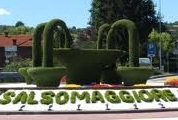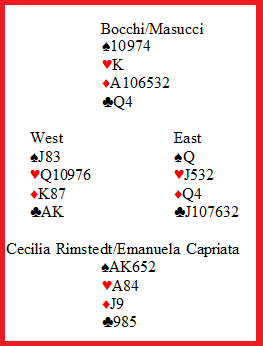leggi in italiano »
 Lavazza Team from Turin won the 2012 Italian Mixted Teams Championships with: Maria Teresa Lavazza, Giorgio Duboin, Cecilia Rimstedt, Norberto Bocchi, Marion Michielsen and Agustin Madala. Second place to team Fornaciari from Bologna with: Carla Gianardi, Ezio Fornaciari, Cristiana Morgantini, Lorenzo Lauria, Monica Buratti and Carlo Mariani. Team Zenari from Trieste completes the podium with: Silvia Urbani, Fabio Zenari, Emanuela Capriata, Nino Masucci, Angela De Biasio and Antonio Cuccorese.
Lavazza Team from Turin won the 2012 Italian Mixted Teams Championships with: Maria Teresa Lavazza, Giorgio Duboin, Cecilia Rimstedt, Norberto Bocchi, Marion Michielsen and Agustin Madala. Second place to team Fornaciari from Bologna with: Carla Gianardi, Ezio Fornaciari, Cristiana Morgantini, Lorenzo Lauria, Monica Buratti and Carlo Mariani. Team Zenari from Trieste completes the podium with: Silvia Urbani, Fabio Zenari, Emanuela Capriata, Nino Masucci, Angela De Biasio and Antonio Cuccorese.
The Italian Mixted Teams Championships were held in Salsomaggiore (Parma, Italy) November 1 to 4, 2012. There were three Series: Excellence (10 teams), A series (3 Groups of 10 teams) and B series (9 groups of 10 teams).
All Italian top players were present, playing for different teams. A curiosity: The Italian stars Claudio Nunes and Fulvio Fantoni, now bona fide resident in Monte-Carlo (Monaco), played for team Palma from Villa Fabbriche (a squad listed in A series). Their participation in these Italian Championships was possible thanks to some changes to the Italian Federattion ‘s Rules.
Before these changes, the paragraph n. 5 of Article 22 of that Rules provided that players who had represented another country at official EBL or WBF events could not play at Italian Championships for at least 3 years. October 28, 2012 the new Rules has been published by Italian Federation and the aforementioned paragraph no. 5 has been deleted.
Rises – Norberto Bocchi in North (N-S vuln) had these cards:
♠10974 ♥K ♦A106532 ♣Q4
East passed, Bocchi’s partner Cecilia Rimstedt opened 1♠, West passed, North raised to 3♠, all passed. +140. At the other table Nino Masucci bid 4♠ instead, -100, + 6 to Bocchi-Rimstedt.
3♠ is a bid suggested by a Total Trick Law’s corollary, committing the pair to play at the same level of the number of their trump cards (nine trumps, nine tricks). But there’s not jail for the outlaws, so it can be broken, also because the so said law is – if it is – a guide more in the contested auction, and here it doesn’t look that opponents are planning to contest.
It must be noted that North has a fine diamond suit or good ruff skill, but not both: if he uses the trumps to ruff, it becomes very difficult to establish the long suit and enter dummy to cash it. All would change, of course, putting the queen or the king into diamonds together with the ace.
That said, if the Opener had the minimum – then would pass an invite – it becomes clear that game chances only would depend on the diamonds owned by the same Opener, and they couldn’t be ascertained. How difficult is to check such values could be explained supposing to bid with inversion: be 2♠ inviting, 3♠ pre-emptive, and let’s see what could happen. If the opener had the minimum, after 1♠-2♠ she would try only with great unbalancing. But the trying suit wouldn’t be diamonds, where she is possibly short, but hearth or club (1♠-2♠; 3♣/♥). What’s more, if the Opener had a 5-5 two suiter, there aren’t chances that she pass the invite, whether it would be made by 2♠, or by 3♠, or by a kind smile.
Conclusion: the long diamond suit, that looks so important, is worth much less in order to establish the game chances because the values that would qualify it are buried in Opener’s hand, and without way to emerge.
The complete hand:

***
November 4, 2012
Laura Camponeschi & Paolo Enrico Garrisi